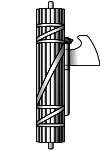Heroic capitalism
| Part of a series on |
| Fascism |
|---|
 |
|
Organizations |
|
Lists |
|
Heroic capitalism or dynamic capitalism was a concept that Italian Fascism took from Werner Sombart's explanations of capitalist development. This phase was known by Sombart as "Early Capitalism"[1] In 1933, Benito Mussolini claimed that capitalism began with dynamic or heroic capitalism (1830-1870) followed by static capitalism (1870-1914) and then reached its final form of decadent capitalism, known also as supercapitalism, which began in 1914.[2]
Mussolini argued that although he did not support this type of capitalism he considered it at least a dynamic and heroic form. Some Fascists, including Mussolini, considered it a contribution to the industrialism and technical developments but claimed that they did not favour the creation of supercapitalism in Italy, due to its strong agricultural sector.[3]
Mussolini claimed that dynamic or heroic capitalism inevitably degenerates into static capitalism and then supercapitalism due to the concepts of bourgeois economic individualism,[4] and instead he proposed a state supervised economy, although he contrasted it to Russian "State Supercapitalism".[5] Italian Fascism presented the economic system of corporatism as the solution that would preserve private initiatives and property while allowing the state and the syndicalist movement to intervene in the economy in the matters where private initiative intervenes in public affairs.[6] This system would lead also to some nationalizations when necessary and the greatest participation of the employees in all the aspects of the company, and in the utility given by the company.
References
- ↑ Mussolini, Benito. Four speeches on the corporate state: with an appendix including the labour charter, the text of laws on syndical and corporate organisations and explanatory notes. Laboremus, 1935. Pp. 16
- ↑ Falasca-Zamponi. Pp. 136.
- ↑ Falasca-Zamponi. 2000. Pp. 136.
- ↑ Falasca-Zamponi. 2000. Pp. 136.
- ↑ Salvemini, Gaetano.Under the Axe of Fascism. READ BOOKS, 2006. Pp. 134.
- ↑ Salvemini. Pp. 134.